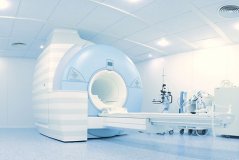
Project
Food structure breakdown in the stomach: combining in vitro and in vivo approaches
A better understanding of gastric digestion of foods can help us to understand the relation between food properties and the physiological mechanisms underlying the absorption of nutrients and feelings of satiety. Up to now, the breakdown of food structures is mainly studied via in vitro models. There is a strong need to verify these data in humans – in in vivo experiments. The current project uses magnetic resonance imaging (MRI) techniques to combine in vitro and in vivo digestion experiments to get a better understanding of food structure breakdown.

The objective of this project is to obtain a better understanding of the breakdown of structured food in the human stomach by utilizing MRI techniques to combine in vitro digestion data with in vivo digestion data.
The project has three phases.
- Structured model foods will be optimized and characterized, as well as MRI protocol on monitoring rheology (indicating the structure property of food) and pH variations of different model foods will be developed.
- In vitro digestion of model foods will be continued and MRI sequences for rheology and pH/[protein] mapping will be refined to monitoring structure breakdown and digestion process.
- In vivo pilot studies with MRI outcomes and effects of food structure on gastric processes will be done. Endocrine and metabolic responses, and satiety will also be tested. Finally, these data will be related with in vitro results.
Publications
-
Monitoring food digestion with magnetic resonance techniques
Proceedings of the Nutrition Society (2021), Volume: 80, Issue: 2 - ISSN 0029-6651 - p. 148-158. -
Exploring in vitro gastric digestion of whey protein by time-domain nuclear magnetic resonance and magnetic resonance imaging
Food Hydrocolloids (2020), Volume: 99 - ISSN 0268-005X -
The importance of swelling for in vitro gastric digestion of whey protein gels
Food Chemistry (2020), Volume: 330 - ISSN 0308-8146 -
Monitoring pH and whey protein digestion by TD-NMR and MRI in a novel semi-dynamic in vitro gastric simulator (MR-GAS)
Food Hydrocolloids (2022), Volume: 125 - ISSN 0268-005X